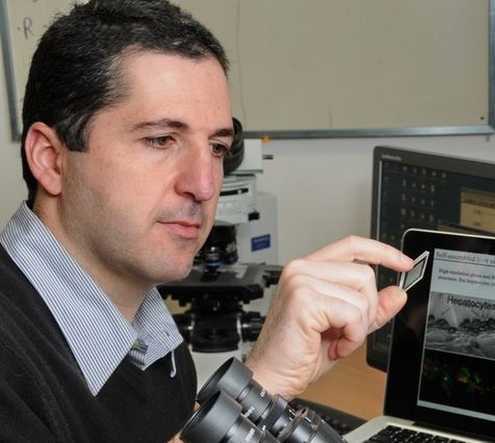New Liver-on-Chip Could Be Used to Assess Mitochondrial Dysfunction, Screen for Safer Drugs

Researchers at The Hebrew University of Jerusalem developed a new “liver-on-chip” that could help scientists understand and study normal liver function and liver disease linked to mitochondrial dysfunction, as well as to screen for new medications.
A study describing the new technology, “Real-time Monitoring of Metabolic Function in Liver-on-Chip Microdevices Tracks the Dynamics of Mitochondrial Dysfunction,“ appeared in the journal Proceedings of the National Academy of Sciences.
The chip is made up of human tissues, with sensors for oxygen, glucose, and lactate. Measurements can be tracked in real-time, and read-outs appear immediately on a computer. The technology will enable the study of cellular processes including mitochondrial function, and will further the understanding of what happens when cells are damaged due to disease.
“Central carbon, or glucose and amino acid, metabolism is by far the most important source of energy and materials for our cells. It is the backbone of cellular function,” said the study’s lead author, Prof. Yaakov Nahmias, director of the Alexander Grass Center for Bioengineering at The Hebrew University of Jerusalem, in a news release. “This metabolic pathway is very sensitive, and any toxic damage will either directly or ultimately lead to changes in glucose metabolism.”
In the report, researchers explained their use of micro-sensors to measure changes in cells when they are exposed to new drugs. Liver toxicity can limit the use of new medications, so the tool can be used to screen for less toxic drugs.
The scientists used the chip to study the medication troglitazone (Rezulin), which was used for diabetes and inflammation until it was removed from the market in 2000 because it induced severe liver injury. The drug cost Pfizer more than $750 million in lawsuits.
Conventional tests did not show liver damage from troglitazone, but the new liver-on-chip technology detected mitochondrial stress. The mitochondria are the powerhouse of cells, and mitochondrial stress can be an early detector of eventual cell death.
The study demonstrated that the chip may be able to detect early signs of eventual cell death.
“The ability to measure metabolic fluxes using small numbers of cells under physiological conditions can redefine the study of neurodegenerative disease, stem cells, and cancer, in addition to drug discovery. In contrast to other instruments, such as the SeaHorse Flux Analyzer, our sensors do not require calibration and our cells do not undergo hypoxia or become exposed to decaying chemical signals due to non-specific absorption,” Nahmias said.
“Our microfluidic system could be of significant interest to biological and clinical laboratories, whose work can range from the study of mitochondria and oxidative stress in neurological disorders (Alzheimer’s, Parkinson’s), to metabolic disease (diabetes, obesity), stem cell biology (pluripotency), virology and cancer,” he added.
Dr. Daniel Duche, former head of the Early Safety Laboratory unit of the Predictive Models and Methods Development Department of L’Oréal Research & Innovation, said Nahmias’s work shows great promise.
“The work performed by Y. Nahmias’s team demonstrates that it becomes possible to monitor dynamically in real time metabolic functions of cells exposed to different drug concentrations over a long period using organ-on-chip microdevices,” Duche said. “That helps to define Adverse Outcome Pathways and brings a real breakthrough in the in vitro alternative methods to animal experimentation for evaluating toxicity of chemicals.”






